It can’t just be a pile of parts
Whether you’ve been coding for a few days or for a few decades, almost every coder is familiar with that moment of inspiration, where you see a new library or framework, or come across a new toolkit or API, and immediately begin to imagine something great that you could build with it.
That exciting early moment gives way to staring blankly at an incomplete and frustrating mess hours later. And you didn’t even get to try the new stuff yet. Obstacles like getting a working dev environment or jumping through hoops to set up a new project sap all of the energy that makes trying new things so much fun. You end up updating dependencies instead of following your creative muse.
If you’re a less-experienced coder, these obstacles can reinforce that nagging sensation of self-doubt, becoming another barrier to bringing new talent into the world of coding. It’s bad for everybody.
The frustration of wasting all of one’s energy on configuration instead of coding is a phenomenon that we talk about a lot while building Glitch. The way we think of it, everyone’s starting point in working with Glitch, or on any coding effort, should be from a working project, which you can then modify to your heart’s content. By contrast, a lot of current practice gives you just a tiny bit of functionality and expects you to assemble the rest of a working app on your own, an approach we sometimes think of as “giving you a pile of parts instead of a working car”. It’s a lot more fun to tinker on a car that runs and to repair or upgrade some parts than it is to assemble an entire vehicle from scratch.
That’s not to say we want to compromise on composability or the philosophy of loosely-coupled pieces. It makes perfect sense from a maintainability standpoint to have code repositories which only include the discrete parts of a single component.
But what if we just want to make something?

In Glitch, we built a platform with a strong bias toward offering starting points that work. When you explore the gallery of projects on Glitch, everything you find works immediately, and you can remix them into your own version with just a click. The default is to give you code that already works, without any setup. And that default is backed up by a wide variety of example projects, organized into a range of different categories, from art to bots to games.
The net result is something that feels wildly empowering to those of us used to fighting with our development environments just to get a project started. In many cases, a large percentage of an idea we’d want to build already exists, and by remixing existing frameworks or toolkits, we can focus on just the part that’s new.
That design frees you to do your most creative work, without the burden of slogging through a bunch of drudgery first. And of course, we’re just getting started, as we’ll be building out a rich library of additional example projects to help you get your next cool app off the ground. If you haven’t yet, we hope you’ll take a look at Glitch when you’re starting your next project, and we’re confident you’ll find it a far faster environment to get to the good parts of creating with code.

